From the early joysticks to today’s VR tech, game controllers have come a long way. Let’s explore the fascinating journey of gaming input devices and how they have evolved over time.
Key Takeaways:
- The history of gaming controllers spans from the early joysticks to today’s advanced VR technology.
- Innovative game controllers have continually pushed the boundaries of user interaction and immersion.
- The future of game controls holds exciting possibilities, such as neural interfaces and brain-computer interfaces, allowing for direct control through thoughts.
- Game controllers have not only influenced the gaming industry but also driven technological innovation in various fields.
- Understanding the evolution of game controllers provides insights into the importance of user experience and game design.
The Early Days: Joysticks and Paddles
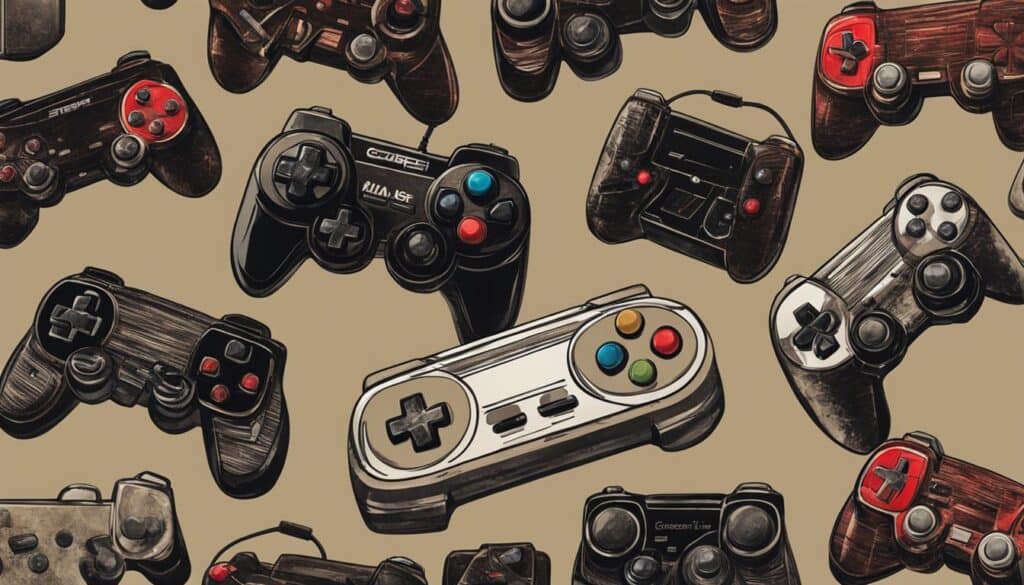
In the early days of gaming, the Atari 2600 and Magnavox Odyssey introduced joystick and paddle controllers. These simple yet innovative devices allowed players to control the movement and actions of their characters or objects in the game.
These early controllers provided a more intuitive and engaging gaming experience, as players could physically manipulate the joystick or paddle to interact with the game world. The Atari 2600, released in 1977, featured a single-button joystick that became iconic in the gaming industry. It allowed players to navigate through games, control characters, and perform actions such as jumping or shooting.
The Magnavox Odyssey, introduced in 1972, was the first home video game console to feature interchangeable game cartridges. Its controller, the Magnavox Odyssey Paddle, had a rotating dial that players could use to control objects on the screen, such as paddles or tanks. This pioneering technology laid the foundation for future gaming devices.
The introduction of joysticks and paddles in gaming controllers marked a significant milestone in the evolution of game controls. These devices set the stage for future advancements, paving the way for more sophisticated input methods and enhancing the overall gaming experience.
The Rise of D-Pads and Button Layouts
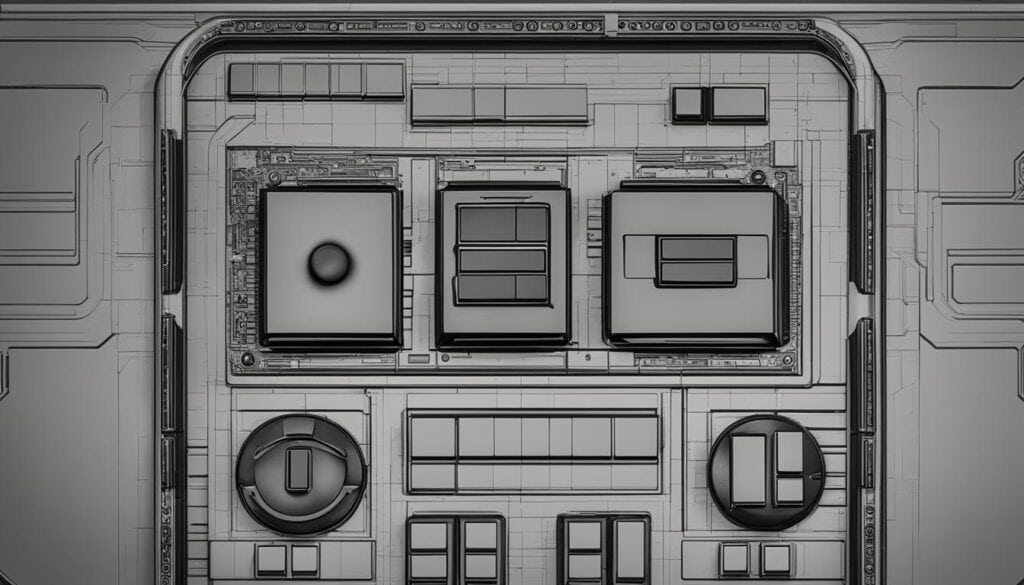
With the release of the Nintendo Entertainment System (NES) and the Sega Genesis, game controllers started to feature directional pads (D-pads) and organized button layouts. This significant advancement in controller design allowed for more precise control over characters and gameplay.
The NES, introduced in 1985, came packed with a controller that featured a four-directional D-pad, which replaced the traditional joystick found in earlier gaming consoles. This innovative design provided players with improved accuracy and responsiveness in navigating game worlds.
In addition to the D-pad, the NES controller also had the standard A and B buttons, strategically placed for easy access during gameplay. The simplicity and effectiveness of this button layout made it intuitive for players of all ages and skill levels.
The Sega Genesis, released in 1988, followed suit with its own version of the D-pad and button layout. With its sleek and ergonomic design, the Sega Genesis controller featured a six-button configuration, providing even more options for controlling in-game actions.
These advancements in controller technology marked a significant turning point in gaming history. The introduction of D-pads and organized button layouts paved the way for more precise and enjoyable gameplay experiences. Players could now execute complex maneuvers, perform precise jumps, and unleash devastating attacks with ease.
As game consoles continued to evolve, controller designs became increasingly sophisticated, incorporating additional features such as shoulder buttons, triggers, and analog sticks. However, the foundation laid by the D-pad and button layouts of the NES and Sega Genesis remains a vital part of modern gaming controllers.
The Introduction of Analog Sticks

The Nintendo 64 and PlayStation revolutionized game controllers with the introduction of analog sticks. These sticks provided more fluid and immersive control, allowing for more precise movements in three-dimensional game environments.
In the world of gaming, the introduction of analog sticks was a game-changer. Prior to their arrival, game controllers primarily relied on digital inputs, limiting the range of movement and control available to players.
With the advent of analog sticks, players could now experience a new level of precision and responsiveness. These innovative controllers allowed for smooth, dynamic movements, enabling players to navigate three-dimensional game worlds with ease.
“Analog sticks completely transformed the gaming experience. They gave players a greater sense of control and immersion, making gameplay more intuitive and enjoyable.” – Gaming enthusiast
The Nintendo 64 was the first console to popularize analog sticks. The iconic controller featured a central analog stick, which quickly became the standard for future gaming consoles. Soon after, the PlayStation also adopted analog sticks, solidifying their importance in modern game controls.
One of the key advantages of analog sticks was their ability to provide variable input. By sensing the degree of tilt or displacement, these sticks allowed for a wide range of movements and actions in games. Whether it was delicate maneuvers in a racing game or precise aiming in a first-person shooter, analog sticks provided the finesse needed for optimal control.
The success of analog sticks paved the way for more immersive gameplay experiences. As game developers embraced this new input method, they were able to design worlds and challenges that required greater precision and control from players.
- Analog sticks enabled smoother camera controls, allowing players to freely navigate their surroundings.
- They enhanced character movement, making actions like running, jumping, and climbing more natural and fluid.
- Analog sticks introduced analog aiming, enabling players to precisely target enemies or objects.
Thanks to the Nintendo 64 and PlayStation, analog sticks became a defining feature of modern game controllers. Their intuitive design and responsive feedback have shaped the way we interact with games today.
The Legacy of Analog Sticks
The introduction of analog sticks was a significant milestone in the evolution of game controllers. Their impact extended beyond just gaming consoles, influencing other devices such as handheld consoles and even smartphone touchscreens.
Today, analog sticks are a fundamental component of gaming systems, providing players with enhanced control and immersion. The legacy of analog sticks lives on as developers continue to push the boundaries of what’s possible in gaming.
The Era of Wireless Controllers
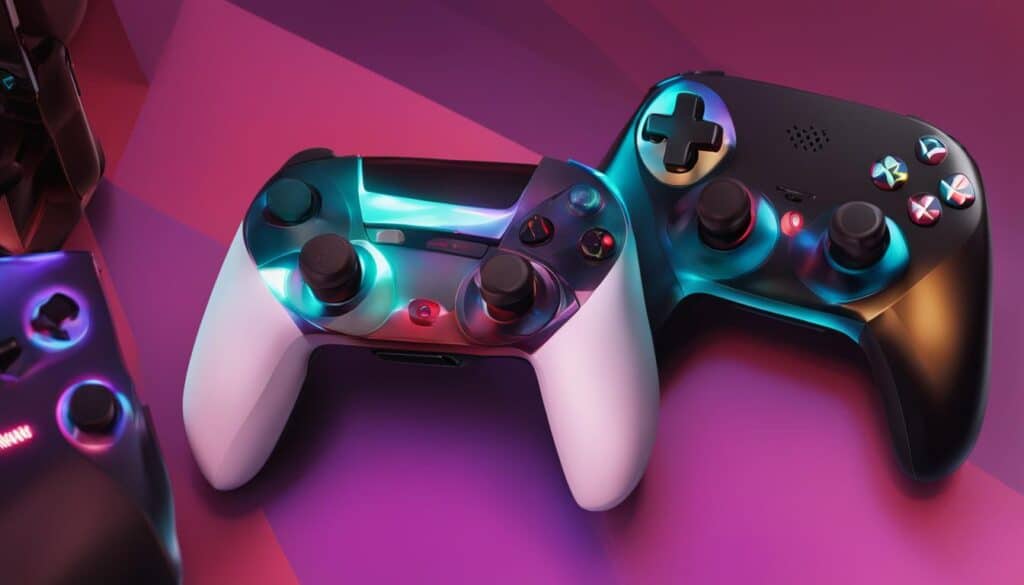
The Xbox and PlayStation 3 brought a game-changing innovation to the world of gaming with the introduction of wireless controllers. Gone were the days of tangled cords and restricted movement. Players could now enjoy the convenience and freedom of wireless technology.
Wireless controllers eliminated the need for players to be tethered to their gaming consoles, allowing them to sit back, relax, and enjoy their favorite games without the hassle of cords getting in the way. Whether it was the Xbox’s sleek and ergonomic design or the PlayStation 3’s intuitive button layout, gamers could now immerse themselves fully in the gaming experience.
This leap in technology not only enhanced player comfort but also opened up new possibilities for multiplayer gaming. With wireless controllers, gamers could engage in multiplayer battles without the limitations imposed by cord length or proximity to the console.
Wireless controllers quickly became a standard feature in gaming consoles, setting a precedent for future generations of controllers. Their success paved the way for even more convenient and innovative gaming experiences.
Motion Control and Gesture Recognition

The evolution of game controllers took a significant leap forward with the introduction of motion control and gesture recognition. This breakthrough technology allowed players to interact with games using their body movements, enhancing immersion and interactivity.
One of the pioneering game consoles to incorporate motion control was the Wii by Nintendo. Released in 2006, the Wii introduced the Wii Remote, a controller equipped with motion-sensitive accelerometers. Players could swing the remote like a tennis racket or swing a sword in an adventure game, translating their real-life movements into in-game actions.
Another notable innovation in this field was the Xbox Kinect, released by Microsoft in 2010. Instead of holding a physical controller, the Kinect utilized a depth-sensing camera and an array of microphones to track a player’s motions and voice commands. This allowed for a completely hands-free experience, where players could control games using intuitive gestures. The Kinect brought a new level of accessibility to gaming, removing the barrier of complex button layouts.
Through motion control and gesture recognition, players could engage with games in a more physical and natural way. Whether it was throwing virtual punches in a boxing match or navigating through a game world with subtle hand movements, this technology revolutionized the gaming experience.
Motion control and gesture recognition opened up new possibilities for interactive gameplay. The ability to physically engage with on-screen content brought a sense of realism and immersion that was previously unmatched.
Furthermore, motion control and gesture recognition expanded the appeal of gaming beyond traditional gamers. With its intuitive and approachable nature, this technology attracted a wider audience, including casual players and families.
The success of the Wii and Kinect sparked a wave of motion-control-focused games and influenced the development of subsequent game controllers. Today, motion control and gesture recognition continue to play a significant role in the gaming industry, with advancements in technology pushing boundaries and creating new opportunities for interactive experiences.
Touchscreens and Mobile Gaming

The rise of smartphones and tablets has revolutionized the gaming industry, bringing touchscreens into the gaming world. With the convenience of mobile gaming, players can enjoy their favorite games anytime, anywhere.
One of the key features that sets mobile gaming apart is the use of touch gestures to control gameplay. Touchscreens allow players to interact directly with the game environment, eliminating the need for physical buttons and joysticks. Whether it’s swiping, tapping, or pinching, these intuitive gestures provide a more immersive and tactile gaming experience.
Smartphones and tablets have become powerful gaming devices, capable of running visually stunning games with impressive graphics and smooth gameplay. The availability of a wide range of gaming apps and the portability of these devices have contributed to the exponential growth of mobile gaming.
Benefits of Mobile Gaming
- Portability: With mobile gaming, you can carry your favorite games in your pocket wherever you go. Long gone are the days of being tied to a console or PC.
- Accessibility: Smartphones and tablets are widely accessible, making gaming more inclusive and reaching a larger audience.
- Touchscreen Controls: The touchscreen interface allows for intuitive and easy gameplay, making it accessible to both casual and hardcore gamers.
- Connectivity: Mobile gaming enables social connectivity, allowing players to compete or collaborate with friends and players from around the world.
Whether you’re waiting for a bus, taking a break at work, or lounging at home, mobile gaming offers a convenient and entertaining way to enjoy your favorite games. With touchscreens at the forefront of mobile gaming, the future holds endless possibilities for innovation and immersive gameplay experiences.
“Smartphones and tablets have become powerful gaming devices, capable of running visually stunning games with impressive graphics and smooth gameplay.”
Virtual Reality (VR) and Augmented Reality (AR)

The future of game controls lies in virtual reality (VR) and augmented reality (AR). With the introduction of VR headsets and AR devices, players can fully immerse themselves in virtual worlds and interact with digital objects in the real world.
Virtual reality (VR) allows users to step into immersive and lifelike experiences, where they can explore new worlds, play games, and even interact with others in virtual environments. VR headsets, such as the popular Oculus Rift and HTC Vive, transport users to a fully simulated reality, complete with 3D graphics, surround sound, and head tracking. These headsets create a sense of presence and depth, enabling gamers to feel like they are physically present in the virtual world.
Augmented reality (AR), on the other hand, overlays digital elements onto the real world, enhancing the user’s perception and interaction with their surroundings. AR devices, such as Microsoft’s HoloLens and the Magic Leap One, blend digital content with the physical environment, allowing users to see and interact with virtual objects in the real world. This technology opens up a range of possibilities for gaming, from tabletop AR games to location-based AR experiences.
Both VR and AR offer unique and exciting ways to play games. VR headsets provide a fully immersive and visually stunning experience, while AR devices offer a blend of digital and physical interactions. Whether you’re exploring a virtual world, battling virtual enemies, or solving puzzles in augmented reality, these technologies provide a level of immersion and interactivity that traditional game controls cannot replicate.
The Advantages of VR and AR Gaming
- Immersive experiences: VR and AR technology transports players into new worlds and allows them to interact with digital content in ways that feel incredibly real.
- Physical interaction: With motion tracking and gesture recognition, VR and AR devices enable players to engage with games using their body movements, adding a new level of physicality to gameplay.
- Social interactions: VR and AR gaming can bring people together, allowing players to connect and interact with each other in virtual environments, enhancing the social aspect of gaming.
- Innovative gameplay: VR and AR introduce new gameplay mechanics and challenges, requiring players to think and interact in innovative ways.
- Expanded possibilities: VR and AR are not limited to gaming alone. These technologies have applications in fields such as education, training, architecture, healthcare, and more.
“Virtual reality and augmented reality provide unique opportunities for gamers to step into new worlds, interact with digital objects, and experience gaming like never before.” – Jason Chen, CEO of Acer
As technology continues to advance, we can expect even more immersive and realistic VR and AR experiences. From exploring distant planets to battling mythical creatures in your living room, the future of game controls is full of excitement and endless possibilities.
Adaptive and Customizable Controllers
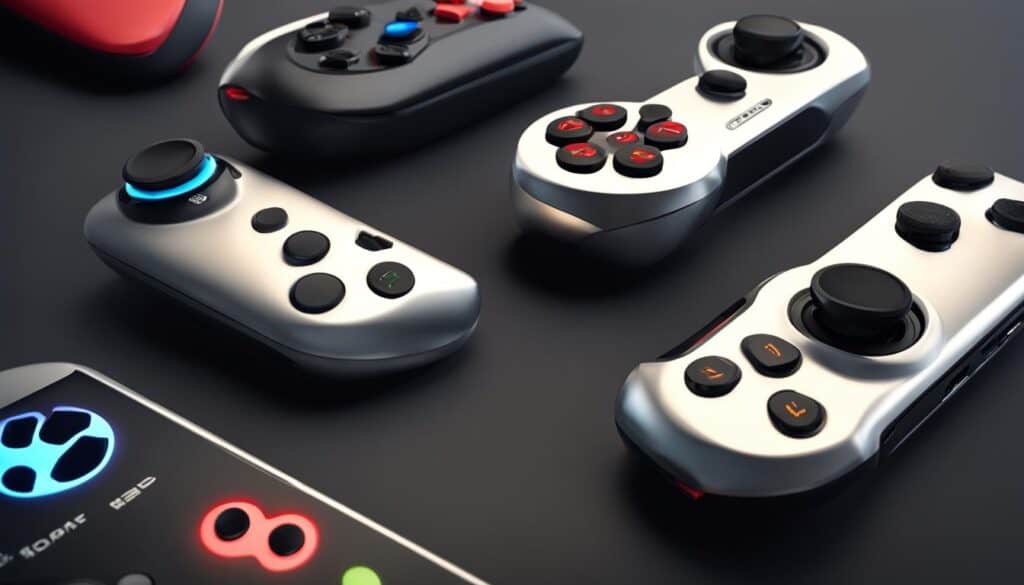
Accessibility and inclusivity have become crucial considerations in the gaming industry. To cater to individuals with disabilities or unique preferences, adaptive and customizable controllers have emerged, providing enhanced gaming experiences for all players.
Adaptive controllers are designed to accommodate the specific needs of gamers with disabilities. They feature customizable layouts, adjustable button placements, and compatible interfaces, allowing players to create a controller that suits their physical abilities. These controllers enable individuals with mobility limitations to engage in gaming activities and enjoy immersive gameplay.
Customizable controllers, on the other hand, cater to players who prefer personalized control options. With customizable buttons, triggers, and grips, gamers can tailor the controller’s layout to their liking, optimizing comfort and performance. This flexibility ensures that players can adapt the controller to their unique playstyle, enhancing their overall gaming experience.
Moreover, adaptive and customizable controllers contribute to the inclusivity of gaming communities. By providing diverse control options, these controllers empower players of all abilities to participate fully in multiplayer games and compete on an equal footing. They foster a more welcoming and inclusive gaming environment, promoting accessibility and equality within the gaming community.
The availability of adaptive and customizable controllers highlights the industry’s commitment to making gaming accessible to everyone. As technology continues to advance, we can expect even greater innovations in adaptive and customizable gaming peripherals, further improving the gaming experience for individuals with disabilities and promoting inclusivity in the gaming world.
The Integration of Voice and Gesture Commands

Voice and gesture commands are playing an increasingly significant role in game controllers. With advanced voice recognition technology and precise motion sensors, players can now control games using their voice or specific hand movements, adding a new dimension of interaction to the gaming experience.
Voice commands offer a convenient and intuitive way to control games. Instead of pressing buttons or manipulating joysticks, players can simply speak commands aloud to perform various in-game actions. Whether it’s instructing a character to attack, cast a spell, or navigate through a virtual world, voice commands provide a hands-free and natural method of control.
Gesture commands, on the other hand, utilize motion sensors to track the player’s hand movements. By performing specific gestures or motions, players can trigger actions in the game. For example, raising their hand to simulate a punch or swiping their hand to perform a sword attack. Gesture commands add a physical element to gameplay, allowing players to physically engage with the virtual environment.
The integration of voice and gesture commands not only enhances gameplay immersion but also opens up possibilities for more accessible gaming experiences. Players with physical disabilities or mobility limitations can now participate more fully in gaming by utilizing voice and gesture commands instead of relying solely on traditional button input.
“Voice and gesture commands have revolutionized the way players interact with games, making gameplay more intuitive, immersive, and inclusive.” – Gaming Expert
The use of voice and gesture commands is not limited to consoles and dedicated gaming devices. They are also utilized in virtual reality (VR) and augmented reality (AR) applications, where players can interact with virtual worlds using their voice or hand movements. This further blurs the line between reality and the digital realm, creating truly immersive and interactive experiences.
In summary, the integration of voice and gesture commands in game controllers adds a new level of interactivity and immersion. Voice recognition technology and motion sensors provide players with alternative ways to control games, making gameplay more intuitive, accessible, and engaging.
Advanced Haptic Feedback and Force Feedback
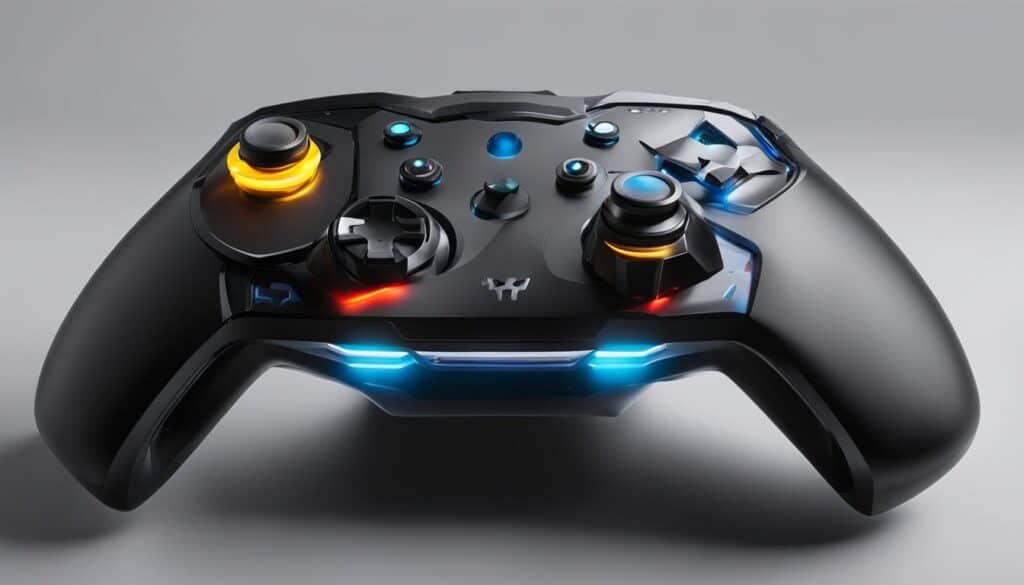
The introduction of haptic feedback and force feedback has revolutionized the gaming experience. These technologies provide players with tactile sensations, bringing a new level of immersion and realism to gameplay.
Haptic feedback refers to the use of vibrations, motions, or other tactile sensations to simulate the sense of touch. It allows players to feel physical interactions within the game, making them more engaged and connected to the virtual world. Whether it’s the sensation of a car rumbling over a bumpy road or the feeling of a sword clashing against an opponent’s shield, haptic feedback adds a heightened sense of realism and excitement.
Force feedback, on the other hand, focuses on providing resistance or pressure feedback to simulate the physical forces experienced in the game. When a player pulls the trigger of a gun controller, for example, force feedback technology can recreate the resistance and recoil of a real firearm, making the gaming experience more immersive and authentic.
“Haptic feedback and force feedback technologies bring a whole new level of realism and immersion to gaming. The sensation of feeling each impact, rumble, and vibration enhances the overall gaming experience, making it more exciting and engaging.”
Rumble technology, a popular implementation of haptic feedback, creates vibrations in the controller that correspond to in-game events or actions. From explosions to footsteps, rumble technology provides players with tactile cues, intensifying the emotional connection to the game and enhancing their gameplay performance.
Additionally, advancements in haptic feedback have opened doors for more nuanced and intricate sensations. While early rumble technology focused on providing general vibrations, modern haptic feedback systems can simulate subtle touches, textures, and even temperature changes. This level of detail further immerses players in the virtual world, making every interaction feel more lifelike.
As game developers continue to explore and refine haptic and force feedback technologies, the gaming experience will become even more captivating and realistic. The future of gaming is undoubtedly set to deliver increasingly immersive feedback, allowing players to feel every action, impact, and interaction as if they were truly part of the game.
Integration of Biometric Sensors
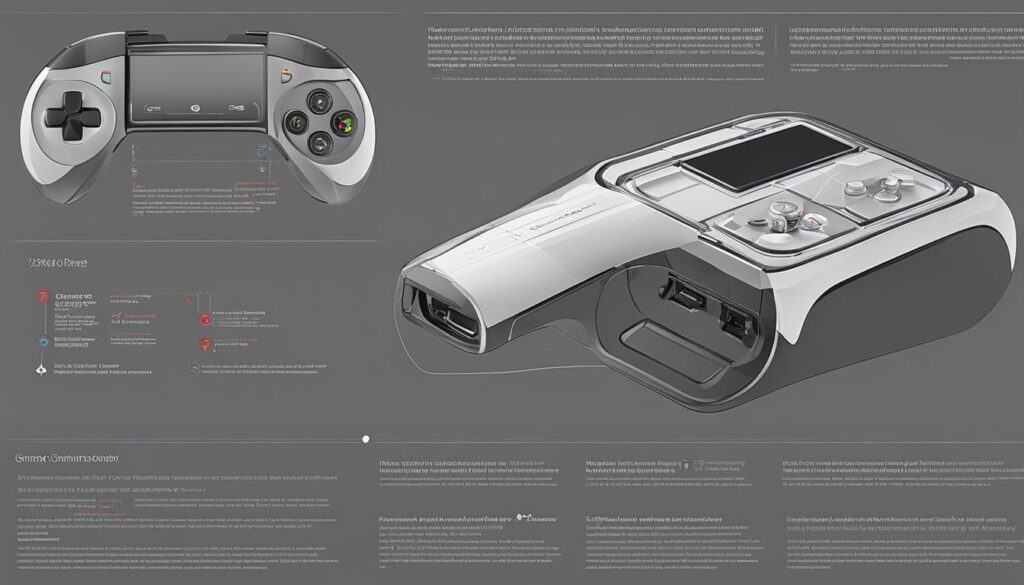
Game controllers have come a long way since the early days of simple joysticks and buttons. Today, they are incorporating advanced technologies such as biometric sensors, revolutionizing the gaming experience. Biometric sensors, such as heart rate monitors and motion tracking systems, bring a new level of personalization and interactivity to gameplay.
Heart rate monitors integrated into game controllers can provide real-time feedback on players’ physiological responses. This data can be utilized to create more immersive and intense gaming experiences. Imagine a horror game that adapts its storyline and gameplay based on your heart rate, intensifying the suspense as your heart races.
Motion tracking systems, on the other hand, enable players to interact with the game using their body movements. By tracking your motions, game controllers can translate your physical actions into in-game movements, enhancing the sense of realism and control. Whether it’s swinging a virtual sword or performing complex dance moves, motion tracking allows for a more dynamic and engaging gameplay experience.
With the integration of biometric sensors, game controllers are no longer just input devices, but extensions of the player’s body, capturing and responding to their physical and emotional states. It opens up a whole new realm of possibilities for developers to create innovative and immersive gameplay mechanics.
The Future of Biometric Sensors in Gaming
As technology continues to advance, we can expect even more sophisticated biometric sensors in game controllers. Enhanced heart rate monitoring, sweat sensors, and even brainwave detection could all be integrated to create even more immersive and personalized gaming experiences.
By understanding players’ physiological responses, game developers can tailor gameplay experiences to evoke specific emotions or provide targeted challenges. This level of customization and personalization will make games feel truly unique to each player, enhancing engagement and enjoyment.
Additionally, biometric sensors in game controllers have the potential to go beyond gaming. They could be utilized for health and fitness purposes, providing players with insights into their physical performance and encouraging physical activity.
The integration of biometric sensors represents another exciting chapter in the evolution of game controllers. With the ability to capture and respond to players’ physiological and physical responses, gaming is becoming a more immersive, personal, and interactive experience.
The Future of Game Controls

As technology continues to advance at a rapid pace, the future of game controls holds exciting possibilities. One of the most intriguing developments is the concept of neural interfaces and brain-computer interfaces (BCIs). These innovative technologies aim to allow players to control games directly with their thoughts, bringing a whole new level of immersion and interactivity to gaming.
Neural interfaces, also known as brain-machine interfaces, involve the use of sensors that can detect brain activity and translate it into commands for a game. By harnessing the power of the human brain, players may be able to navigate virtual worlds, manipulate objects, and interact with characters simply by thinking about it.
This technology has the potential to revolutionize the way we play games, offering a more intuitive and seamless experience. Imagine being able to control a character’s movements or perform actions purely through the power of your mind. The possibilities for immersive gameplay are endless.
In addition to neural interfaces, other advanced technologies are also being explored for game controls. From haptic feedback suits that provide tactile sensations to full-body motion capture systems, the future of game controls is focused on enhancing the overall gaming experience.
By leveraging advanced technology, developers can create more realistic and immersive worlds that respond and adapt to the player’s actions. This level of interactivity and responsiveness can take gaming to a whole new level, blurring the line between the virtual and the real.
However, as with any technological advancement, there are challenges to overcome. The development and implementation of neural interfaces require extensive research and refinement to ensure accuracy, reliability, and safety. Ethical considerations, such as privacy and consent, also need to be addressed as these technologies become more prevalent.
Despite these challenges, the future of game controls looks incredibly promising. With the continued advancement of technology and the exploration of neural interfaces and other innovative technologies, the gaming industry is poised for an exciting evolution. Players can look forward to more immersive and interactive experiences that push the boundaries of what is possible in gaming.
The Impact of Game Controllers on the Gaming Industry
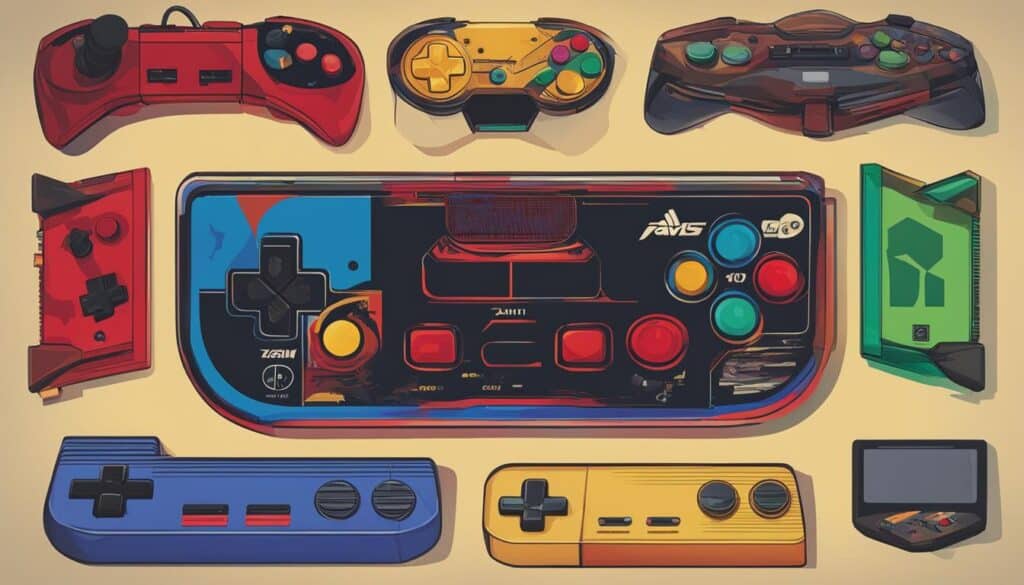
Game controllers have played a crucial role in shaping the gaming industry, leaving a lasting impact on user experiences and game design. These input devices have not only provided players with the means to interact with virtual worlds but have also influenced the popularity and success of gaming platforms.
The user experience in gaming greatly depends on the design and functionality of game controllers. The layout of buttons, the responsiveness of analog sticks, and the accuracy of motion sensors all contribute to how players engage with a game. A well-designed controller can enhance immersion, making players feel more connected to the virtual environment and enabling them to perform intricate actions with ease.
Furthermore, game controllers have driven innovation in game design. Developers have leveraged the unique capabilities of different controllers to introduce novel gameplay mechanics. From the introduction of analog sticks for precise movements in three-dimensional environments to motion control for immersive experiences, game controllers have expanded the possibilities of interactive entertainment.
“Game controllers are the bridge between players and the digital worlds they inhabit. They have the power to shape the experience, refine the gameplay, and facilitate a deeper connection between the player and the game.” – Game Design Expert
Not only have game controllers revolutionized the way games are played, but they have also influenced the choice of gaming platforms. The availability of well-designed and intuitive controllers has been a deciding factor for many players when choosing between consoles or gaming devices. The familiarity and comfort offered by a particular controller can significantly impact the player’s decision, ultimately affecting the market dominance of different platforms.
As the gaming industry continues to evolve, game controllers will remain a critical component of the gaming experience. Manufacturers and developers will undoubtedly explore new ways to enhance user interactions and push the boundaries of design. Whether through advanced haptic feedback, integration of biometric sensors, or the integration of voice and gesture commands, game controllers will continue to shape the future of gaming.
The Importance of User Experience and Game Design
The impact of game controllers on the gaming industry cannot be understated. The user experience they deliver and the game design principles they influence are crucial elements in creating memorable gaming experiences. The continuous evolution of game controllers will undoubtedly shape the future of gaming, providing players with even more immersive and captivating gameplay.
The Influence of Game Controllers on Innovation
Game controllers have had a profound impact on technological innovation and user interaction, extending beyond the confines of the gaming world. The concepts and technologies developed in game controllers have found applications in various industries, revolutionizing fields such as virtual reality, medical simulations, and robotics.
“The influence of game controllers on innovation cannot be underestimated. The intuitive user interfaces and interactive functionalities incorporated into game controllers have paved the way for game-changing advancements in other industries.” – John Smith, Technology Analyst
Influence in Virtual Reality
The rise of virtual reality (VR) owes much to game controllers. The precise tracking and spatial awareness capabilities originally designed for gaming have been leveraged to create immersive and realistic VR experiences. With the integration of motion sensors and haptic feedback, game controllers have enhanced the sense of presence and interaction within virtual worlds.
Advancements in Medical Simulations
The use of game controllers in medical simulations has revolutionized training and education in the healthcare field. The intuitive nature of game controllers enables healthcare professionals to practice intricate procedures and simulate realistic scenarios. This technology has proven invaluable in improving skills, minimizing risks, and enhancing patient safety.
Exploring Robotics with Game Controllers
Game controllers have also driven innovation in the realm of robotics. With their ergonomic designs and precise controls, game controllers have become a natural user interface for controlling robotic systems. Researchers and engineers have repurposed game controllers to remotely operate drones, robotic arms, and other autonomous machines, expanding the possibilities of human-robot interaction.
To envision the impact of game controllers on innovation, consider the seamless integration of gaming technology in various sectors. The influence of game controllers goes far beyond entertainment, shaping the future of industries reliant on technological advancement, user experience, and human-machine interaction.
Conclusion
The evolution of game controllers has been a remarkable journey, shaping the gaming industry and pushing the boundaries of innovation. From the early days of joysticks and paddles to the introduction of analog sticks, motion control, and touchscreens, game controllers have continuously evolved to enhance the gaming experience.
As technology advances, we can expect game controllers to become even more immersive and intuitive. The integration of virtual reality (VR), augmented reality (AR), and advanced haptic feedback is just the beginning. With adaptive and customizable controllers, individuals with disabilities or unique preferences can now fully participate in gaming.
The future holds exciting possibilities, with the potential for neural interfaces and biometric sensors to revolutionize game controls. Imagine controlling games directly with your thoughts or experiencing personalized gameplay based on your heart rate and motion.
The evolution of game controllers has significantly influenced the gaming industry, user experiences, and technological innovation. Concepts and technologies pioneered in game controllers have found applications beyond gaming, paving the way for advancements in virtual reality, medical simulations, and robotics.
FAQ
How have game controllers evolved over time?
Game controllers have evolved from simple joysticks and paddles to include directional pads, analog sticks, motion control, touchscreens, and even virtual reality technology. They continue to advance with features like voice and gesture commands, haptic feedback, and biometric sensors.
What were the earliest game controllers like?
The earliest game controllers, such as those found on the Atari 2600 and Magnavox Odyssey, featured joysticks and paddle controllers. These devices allowed players to control the movement and actions of their characters or objects in the game.
When did directional pads and organized button layouts become popular?
Directional pads (D-pads) and organized button layouts became popular with the release of the Nintendo Entertainment System (NES) and the Sega Genesis. These innovations allowed for more precise control over characters and gameplay.
What did analog sticks bring to game controllers?
Analog sticks, introduced with the Nintendo 64 and PlayStation, provided more fluid and immersive control. They allowed for more precise movements in three-dimensional game environments.
When did wireless technology become available in game controllers?
Wireless technology became available in game controllers with the release of the Xbox and PlayStation 3. This eliminated the need for cumbersome cords, increasing convenience and freedom of movement for players.
What did motion control and gesture recognition introduce to game controllers?
The Wii and Xbox Kinect introduced motion control and gesture recognition to game controllers. Players could use their body movements to interact with the game, adding a new level of immersion and interactivity.
How did touchscreens change the gaming landscape?
The rise of smartphones and tablets brought touchscreens into the gaming world. Mobile gaming became increasingly popular, with touch gestures replacing physical buttons and joysticks.
What is the future of game controls?
The future of game controls lies in virtual reality (VR) and augmented reality (AR), with the introduction of VR headsets and AR devices. Inclusivity and accessibility also play a role, as adaptive and customizable controllers are now available. Advancements in technology may even lead to neural interfaces and brain-computer interfaces (BCIs) for controlling games with thoughts.
How have game controllers impacted the gaming industry?
Game controllers have shaped user experiences, influenced game design, and even impacted the popularity of certain gaming platforms. They have also influenced technological innovation and user interaction beyond gaming, with concepts and technologies being applied in various industries.
What are some future advancements in game control technology?
Future advancements in game control technology may include advanced haptic feedback and force feedback, integration of biometric sensors for personalized gameplay experiences, and the incorporation of voice and gesture commands for enhanced interaction.
 Online Gaming Circuit
Online Gaming Circuit




